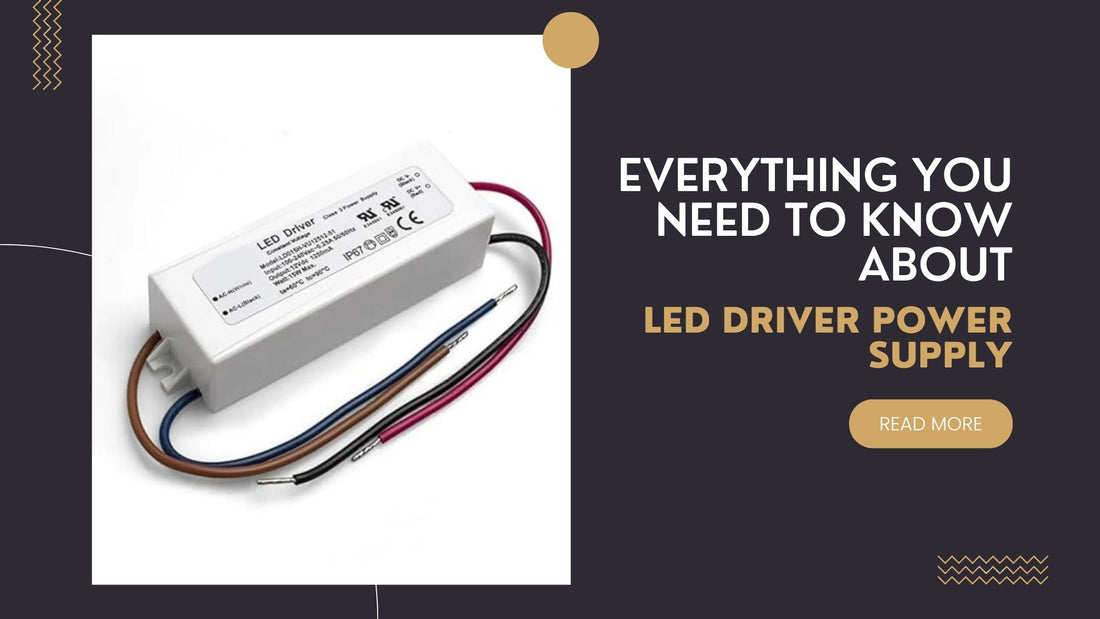
Everything You Need to Know About LED Driver Power Supply
Share
Introduction
LED lighting has revolutionized the way we illuminate spaces, offering energy efficiency, longevity, and versatility. However, the performance of LEDs heavily depends on the quality and compatibility of the LED driver power supply. This guide delves into the intricacies of LED drivers, their types, applications, and how to choose the right one for your needs.
What Is an LED Driver Power Supply?
An LED driver power supply is a critical component that regulates the power delivered to an LED or a string of LEDs. Unlike traditional incandescent or fluorescent lights, LEDs operate on low-voltage DC power and require precise current or voltage regulation to function optimally. The LED driver ensures that the LEDs receive a consistent and stable power supply, protecting them from voltage fluctuations that could lead to overheating, flickering, or premature failure.

Why Do LEDs Need Drivers?
LEDs are semiconductor devices that are highly sensitive to changes in voltage and current. Without a driver, an LED connected directly to a power source would experience uncontrolled current flow, leading to rapid degradation or burnout. The LED driver power supply acts as a mediator, converting the incoming AC or DC power into a form that matches the LED's requirements. This ensures longevity, efficiency, and consistent brightness.
Types of LED Driver Power Supplies
There are two primary types of LED driver power supplies, each designed for specific applications:
- Constant Current Drivers: These drivers provide a fixed current output, measured in milliamperes (mA) or amperes (A). They are ideal for high-power LEDs, such as those used in streetlights or industrial lighting, where maintaining a specific current is crucial for performance and safety.
- Constant Voltage Drivers: These drivers deliver a fixed voltage output, typically 12V or 24V. They are commonly used for LED strips, signage, and other low-voltage applications where multiple LEDs are connected in parallel.
Comparing Constant Current vs. Constant Voltage Drivers
| Feature | Constant Current | Constant Voltage |
|---|---|---|
| Output Type | Fixed current | Fixed voltage |
| Best For | High-power LEDs | LED strips, signage |
| Flexibility | Less flexible | More flexible |
Applications of LED Driver Power Supplies
LED driver power supplies are versatile and find applications across various sectors:
- Residential Lighting: Used in downlights, track lighting, and under-cabinet lighting to ensure consistent brightness and energy efficiency.
- Commercial Lighting: Essential for office buildings, retail stores, and hotels, where lighting quality and reliability are paramount.
- Industrial Lighting: Deployed in warehouses and factories to provide durable and long-lasting illumination under harsh conditions.
- Outdoor Lighting: Ideal for streetlights, landscape lighting, and architectural lighting, offering weather-resistant performance.
Case Study: Energy Savings with LED Drivers
A study by the U.S. Department of Energy highlights the significant energy savings achievable with LED driver power supplies. By replacing traditional lighting systems with LED solutions, energy consumption can be reduced by up to 50%, translating to lower utility bills and a smaller carbon footprint.
How to Choose the Right LED Driver Power Supply

Selecting the right LED driver power supply involves careful consideration of several factors:
- Voltage and Current Requirements: Ensure the driver's output matches the LED's specifications to avoid underpowering or overpowering.
- Dimming Capabilities: If dimming is required, choose a led driver with dimming technology (e.g., PWM, TRIAC). Many options are available in the led driver dimmable category to support smooth brightness control.
- Efficiency: High-efficiency drivers (90% or above) minimize energy loss and heat generation.
- Environmental Conditions: Select drivers with appropriate IP ratings for indoor or outdoor use, ensuring durability against dust, moisture, and temperature extremes.
Table: Key Specifications to Check
| Specification | Why It Matters |
|---|---|
| Input Voltage | Must match your power source (e.g., 120V AC, 240V AC). |
| Output Voltage/Current | Must align with the LED's requirements for optimal performance. |
| IP Rating | Indicates protection levels against environmental factors (e.g., IP65 for outdoor use). |
Common Issues with LED Driver Power Supplies
Despite their advantages, LED driver power supplies can face challenges:
- Flickering: Often caused by incompatible dimmers or low-quality drivers. Upgrading to a compatible driver or using a high-quality dimmer can resolve this issue.
- Overheating: Occurs when the driver is undersized or lacks proper ventilation. Ensure adequate cooling and select a driver with sufficient capacity.
- Premature Failure: Typically results from voltage spikes or manufacturing defects. Using surge protectors and purchasing from reputable brands can mitigate this risk.
Conclusion
Choosing the right LED driver power supply is pivotal for maximizing the performance and lifespan of your LED lighting system. By understanding the types, applications, and selection criteria, you can make informed decisions tailored to your specific needs. Whether for residential, commercial, or industrial use, investing in a high-quality LED driver ensures energy efficiency, reliability, and long-term cost savings.
FAQs About LED Driver Power Supplies
1. What is the lifespan of an LED driver?
Most LED driver power supplies last between 50,000 and 100,000 hours, depending on quality, usage conditions, and environmental factors.
2. Can I use any LED driver with my LED lights?
No, the driver must match the voltage and current requirements of your LEDs. Mismatched drivers can lead to poor performance or damage.
3. Are dimmable LED drivers more expensive?
Yes, dimmable drivers incorporate advanced circuitry to support dimming, making them costlier than non-dimmable counterparts.
4. How do I know if my LED driver is failing?
Common signs include flickering, inconsistent brightness, or complete failure to power the LEDs. Testing with a multimeter can confirm the issue.
5. Can I repair a faulty LED driver?
While minor repairs are possible, it is often more economical to replace the driver, especially if it is out of warranty or severely damaged.
Frequently Linked pages:
1. LED Driver Dimmable - Lighting Control Made Easy with Dimmable LED Driver
2. LED Driver with Dimming - A Complete Guide to LED Driver with Dimming for Modern Lighting
3. LED Driver - The Ultimate Guide to LED Driver: Types, Benefits, and Applications
